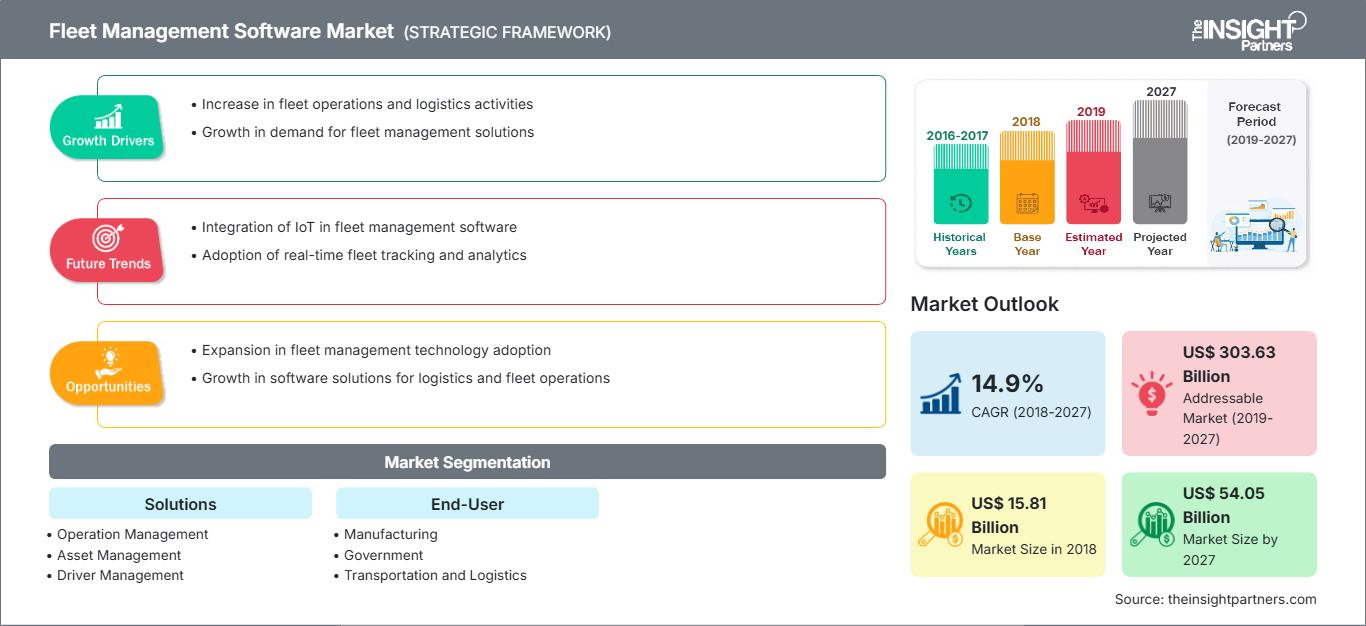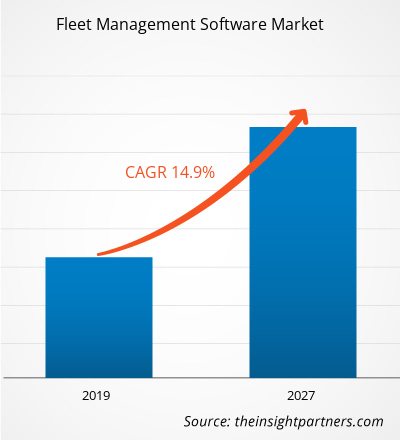Le marché mondial des logiciels de gestion de flotte devrait passer de 15,81 milliards de dollars américains en 2018 à 54,05 milliards de dollars américains d'ici 2027. Cela représente un TCAC de 14,9 % entre 2019 et 2027.
L'Europe était le premier marché géographique et devrait être le plus gros contributeur de revenus tout au long de la période de prévision. La taille du marché européen des logiciels de gestion de flotte devrait augmenter progressivement dans les années à venir jusqu'en 2027, en raison de l'augmentation des dépenses dans le secteur automobile dans la région.
Aperçu du marché : L'utilisation des technologies sans fil pour les opérations de flotte devrait stimuler le marché.
Actuellement, l'industrie du sans fil connaît une croissance considérable et établit de nouveaux records en termes de trafic réseau, d'infrastructure réseau et de déploiement de connexions sans fil. Grâce à la mise en œuvre de l'Internet des objets (IoT) à l'échelle mondiale, il est possible d'améliorer divers systèmes utilisés dans diverses industries grâce aux technologies sans fil. Les technologies sans fil jouent un rôle important dans l'économie de nombreux pays à travers le monde. Plusieurs pays potentiels contribuent à l'économie nationale et lui permettent de rester compétitif sur le marché. Par exemple, selon la CTIA, une association professionnelle du secteur des communications sans fil basée aux États-Unis, le secteur du sans fil a contribué à hauteur de 475 milliards de dollars par an à l'économie américaine en 2016.
Plusieurs entreprises utilisent des logiciels de gestion de flotte pour contrôler leurs véhicules. L'intégration des technologies sans fil aux logiciels de gestion de flotte améliore l'efficacité des flottes et contribue à alléger la charge de travail des opérateurs. Les technologies sans fil, telles que le GPS et les systèmes de localisation de véhicules, permettent d'obtenir une vision exceptionnelle des performances de la flotte. Ces technologies sans fil améliorent également le comportement du conducteur en surveillant la vitesse du véhicule, les freinages brusques, et bien plus encore. De plus, selon une étude, environ 13 millions d'appareils dotés d'une connectivité sans fil sont déployés pour gérer les véhicules de flotte, et ce chiffre pourrait augmenter au cours de la période de prévision. Ainsi, en raison de l'importance accrue accordée aux technologies sans fil dans les opérations des véhicules, les fournisseurs peuvent accroître leur productivité et leur efficacité, ce qui stimulerait le marché mondial des logiciels de gestion de flotte au cours de la période de prévision.
Personnalisez ce rapport en fonction de vos besoins
Vous bénéficierez d’une personnalisation sur n’importe quel rapport - gratuitement - y compris des parties de ce rapport, ou une analyse au niveau du pays, un pack de données Excel, ainsi que de profiter d’offres exceptionnelles et de réductions pour les start-ups et les universités
Marché des logiciels de gestion de flotte: Perspectives stratégiques

- Obtenez les principales tendances clés du marché de ce rapport.Cet échantillon GRATUIT comprendra une analyse de données, allant des tendances du marché aux estimations et prévisions.
Marché mondial des logiciels de gestion de flotte - Aperçu des solutions
Vous bénéficierez d’une personnalisation sur n’importe quel rapport - gratuitement - y compris des parties de ce rapport, ou une analyse au niveau du pays, un pack de données Excel, ainsi que de profiter d’offres exceptionnelles et de réductions pour les start-ups et les universités
Marché des logiciels de gestion de flotte: Perspectives stratégiques

- Obtenez les principales tendances clés du marché de ce rapport.Cet échantillon GRATUIT comprendra une analyse de données, allant des tendances du marché aux estimations et prévisions.
Le marché mondial des logiciels de gestion de flotte, par solution, était dominé par le segment de la gestion des opérations. Le segment de la maintenance et de la location de véhicules représentait le deuxième marché en importance en 2018 et devrait voir sa part augmenter au cours de la période de prévision de 2019 à 2027.
Marché mondial des logiciels de gestion de flotte - Aperçu des utilisateurs finaux
Le marché mondial des logiciels de gestion de flotte, par utilisateur final, était dominé par le segment du transport et de la logistique. Le segment de la fabrication représentait le deuxième marché en importance en 2018 et devrait voir sa part augmenter au cours de la période de prévision de 2019 à 2027.
Les acteurs du marché des logiciels de gestion de flotte se concentrent principalement sur l'amélioration des produits en mettant en œuvre des technologies de pointe. La signature de partenariats, de contrats, de coentreprises, de financements et l'inauguration de nouveaux bureaux à travers le monde permettent à l'entreprise de maintenir sa marque à l'échelle mondiale. Voici quelques-uns des développements récents :
2019 : En avril 2019, Geotab, Inc. a annoncé un accord pour l’acquisition de BSM Technologies, un fournisseur de solutions de télématique et de gestion d’actifs. En mettant en œuvre la solution de Geotab, les clients de BSM, issus du secteur public et de secteurs verticaux tels que la construction, les services et le secteur ferroviaire, bénéficieront d’une visibilité accrue sur les habitudes des conducteurs, les performances des véhicules, la détection des accidents, etc. 2019 : En mars 2019, Omnitracs, LLC a acquis Blue Dot Solutions, une société de logiciels. Omnitracs, LLC intégrerait la suite de produits MilesAhead de Blue Dot, offrant ainsi au secteur une solution dotée d’une capacité exceptionnelle à améliorer la productivité, la flexibilité, l’évolutivité et la sécurité des opérations de flotte globales. 2018 : En juin 2018, Geotab Inc. a acquis FleetCarma, spécialisée dans la télématique pour véhicules électriques (VE). L'acquisition avec FleetCarma permettrait à son client de fournir une solution complète de gestion de flotte.
Aperçu régional du marché des logiciels de gestion de flotte
Les tendances régionales et les facteurs influençant le marché des logiciels de gestion de flotte tout au long de la période de prévision ont été analysés en détail par les analystes de The Insight Partners. Cette section aborde également les segments et la répartition géographique du marché des logiciels de gestion de flotte en Amérique du Nord, en Europe, en Asie-Pacifique, au Moyen-Orient et en Afrique, ainsi qu'en Amérique du Sud et en Amérique centrale.
Portée du rapport sur le marché des logiciels de gestion de flotte
| Attribut de rapport | Détails |
|---|---|
| Taille du marché en 2018 | US$ 15.81 Billion |
| Taille du marché par 2027 | US$ 54.05 Billion |
| TCAC mondial (2018 - 2027) | 14.9% |
| Données historiques | 2016-2017 |
| Période de prévision | 2019-2027 |
| Segments couverts |
By Solutions
|
| Régions et pays couverts | Amérique du Nord
|
| Leaders du marché et profils d'entreprises clés |
|
Densité des acteurs du marché des logiciels de gestion de flotte : comprendre son impact sur la dynamique des entreprises
Le marché des logiciels de gestion de flotte connaît une croissance rapide, portée par une demande croissante des utilisateurs finaux, due à des facteurs tels que l'évolution des préférences des consommateurs, les avancées technologiques et une meilleure connaissance des avantages du produit. Face à cette demande croissante, les entreprises élargissent leur offre, innovent pour répondre aux besoins des consommateurs et capitalisent sur les nouvelles tendances, ce qui alimente la croissance du marché.

- Obtenez le Marché des logiciels de gestion de flotte Aperçu des principaux acteurs clés
- Analyse historique (2 ans), année de base, prévision (7 ans) avec TCAC
- Analyse PEST et SWOT
- Taille du marché Valeur / Volume - Mondial, Régional, Pays
- Industrie et paysage concurrentiel
- Ensemble de données Excel
Rapports récents
Rapports connexes
Témoignages
Raison d'acheter
- Prise de décision éclairée
- Compréhension de la dynamique du marché
- Analyse concurrentielle
- Connaissances clients
- Prévisions de marché
- Atténuation des risques
- Planification stratégique
- Justification des investissements
- Identification des marchés émergents
- Amélioration des stratégies marketing
- Amélioration de l'efficacité opérationnelle
- Alignement sur les tendances réglementaires




















 Obtenez un échantillon gratuit pour - Marché des logiciels de gestion de flotte
Obtenez un échantillon gratuit pour - Marché des logiciels de gestion de flotte